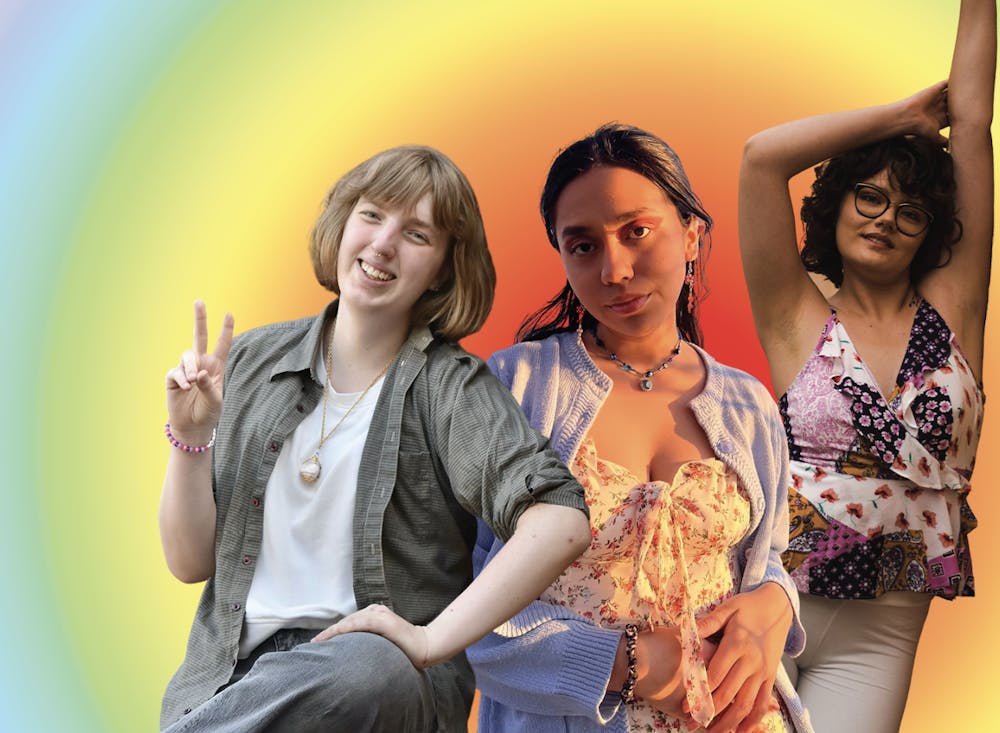From the Newsstands: This story appeared in The Eagle's April 2022 print edition. You can find the digital version here.
For generations, art has translated and preserved experiences. At American University, many LGBTQ+ students find an intersection between community and art, enabling the exploration of identity.
With queer autonomy regularly threatened by anti-LGBTQ legislation, many LGBTQ+ students they create their own power through art. Gretchen, a junior in the College of Arts and Sciences, has found this power through dance.
“As someone who struggles with mental illness, I have a lot of issues doubting myself and believing that I’m worthy,” Venema said. “But when I dance I can feel my own power and know that I already have worth. Power is really important because it reminds me I have agency over my own body.”
After coming out as nonbinary during their sophomore year, Venema explored their physical connection to their body through choreographing. Venema did this through AU’s Choreolab, a class where dancers choreograph their own piece.
“My Choreolab piece was about gender,” Venema said. “It was titled ‘Beyond the Binary,’ and it was just a great way to see how gender manifests itself in other bodies and compare that to my own body.”
Similarly, for CAS freshman Mona Garza, the process of understanding your identity doesn’t stop after coming out.
“I realized art was an outlet for me to illustrate my emotions. It became a coping mechanism for me,” Garza said. “I think verbally articulating things is hard sometimes so I would sit down and visualize how I feel.”
Oftentimes, LGBTQ+ members aren’t accepted from the communities they were raised in, making college a first opportunity to truly process their identity. Art acts as a vehicle to not only reflect on identity in a safe space, but connect with other LGBTQ+ members going through similar experiences.
Sophie Lavender, a freshman in CAS, drew inspiration from other artists in the community when exploring their identity.
“I have this book called ‘Lunch Poems’ by Frank O’Hara, which I’ve been carrying since I was in the closet my freshman year. He was such an ‘out’ person in such a horrible time — during the 1950s — which I think is very inspiring,” Lavender said. “When I was very young and closeted I would use writing as a way to connect to things that felt like community in a place where I didn’t have any community.”
The AU theater department is one community where LGBTQ+ students can bond over shared experiences and support each other in their journey of self expression. For CAS senior Nicole Klokiw, she first discovered her sexuality through the community built in her high school theater training program.
“Acting has always been validating because it was the first time I was in a community with other gay people and queer people and it helped me acclimate to the idea that being bi is normal,” Klokiw said.
Klokiw shared her lack of confidence in her bisexuality prior to entering college. Now as a senior, she can reflect on how this epiphany was a validating experience. The prevalent LGBTQ+ community on campus has fostered previously unappreciated aspects of her identity.
CAS freshman Simon Huynh explained how theater helped him embrace being gay. For him, acting allows experimentation with identity because it’s a rare space where one can literally put themselves in another’s shoes.
“You can try on many different hats when you're acting and that can be a way in which to discover different parts of yourself,” Huyhn said.
While Klokiw and Huyhn point out how theater is a welcoming space for LGBTQ+ students, many agree that there is work to be done. There is still a disconnect between administration and student artists.
“I think more visibility in the arts would be amazing,” Venema said. “We really need more recognition from higher up administration. We try to advertise and promote events, but we can’t do it all on our own. We need assistance.”
Karl Kippola, the director of the theater and musical theater program at AU, affirmed that diversity is a priority for the theater department and hopes to cultivate inclusivity through increasing student input.
“Prior to the last couple of years, most of the seasons were selected by the faculty directing the productions, but for the last two years we’ve had a season selection committee that also includes students,” Kippola said. “This makes sure the student voice is heard.”
And while it is important to uplift the work being done to make theater more representative, students also say the lack of diversity on stage must be acknowledged.
“There are hardly any female roles that are queer, let alone male [queer] roles,” Klokiw said.
Such is true not just in LGBTQ+ representation, but also in gender and racial diversity.
“I'm Asian American so that's another aspect to it,” Huyhn said. “My high school was predominantly white so it was definitely something I noticed, but I was used to it. That's definitely an issue, especially when you're doing old productions and some of them will have racism embedded in them in some way and heteronormativity.”
For some students, LGBTQ+ erasure is still as prominent of a battle on campus as it is in the rest of the country. Still, art has not only been an escape, but an important documentation of the history and journey to self and societal acceptance.
“Frank O’Hara is explicitly queer, which is something I look up to, but also the resilience of closeted artists is worthy too,” Lavender said. “In our art there is an expression of independence and liberation.”
According to Venema, one way to amplify marginalized voices is to support the art they create.
“Queer art is for everyone,” Venema said. “I want it to help cisgender, heterosexual people understand the queer experience and really empathize and get a glimpse into my life as a queer person. Queer art is not something you should be scared of."





